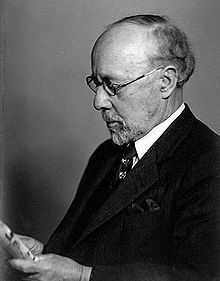John Garstang
| John Garstang | |
|---|---|
|
John Garstang aged 80 | |
| Born |
May 5, 1876 Blackburn, England |
| Died |
September 12, 1956 Beirut, Lebanon |
| Nationality | British |
| Fields | Archaeology |
| Institutions | University of Liverpool |
John Garstang (May 5, 1876 – September 12, 1956) was a British archaeologist of the ancient Near East, especially Anatolia and the southern Levant.
John Garstang was born to Walter Garstang of Blackburn and was the younger brother of Professor Walter Garstang, FRS, a marine biologist and zoologist. He was educated at Queen Elizabeth's, Blackburn; and Jesus College, Oxford.[1] Following undergraduate studies in mathematics at Oxford, his attentions turned to archaeology.
From 1897 to 1908 he conducted excavations at Roman sites in Britain, Egypt, Nubia, Asia Minor and North Syria; in the Sudan and Meroe between 1909 and 1914, then in Palestine at Ashkelon (1920–1921) and in Trans-Jordan at Jericho (Tell es-Sultan) in 1930–1936.
He was Professor of Archaeology at the University of Liverpool from 1907 to 1941.
He served as the Director of the Department of Antiquities in the British Mandate of Palestine between 1920 and 1926, as well as filling the position of Head of the British School of Archaeology in Jerusalem (1919–1926). He taught at the Egyptology section of the Faculty of Arts when this was established in the 1920s. One of his students was Pahor Labib, late Director of the Coptic Museum, Cairo.[2]
Later, in 1947, Garstang founded the British Institute of Archaeology at Ankara, acting as its first director (he was succeeded by Seton Lloyd).
The methods and publication of his excavations are very selective. Many finds were not published; maps and plans are often much too small and important details are missing. Modern researchers have criticised him for this lack of care.[3]
Further reading
- Albright, William Foxwell. "John Garstang in Memoriam", Bulletin of the American Schools of Oriental Research, No.144. (Dec., 1956), pp. 7–8.
- Garstang, John. "A History of Blackburn Grammar School", North-East Lancashire Press Co., 1897
- Garstang, John. "El Arabah: A Cemetery of the Middle Kingdom...", London, Bernard Quaritch, 1901.
- Garstang, John. "Mahasna and Bet Khallaf", London, Bernard Quaritch, 1902.
- Newberry, Percy E., Garstang, John. "A Short History of Ancient Egypt", London, Archibald Constable & Co. 1904.
- Garstang, John. "The Burial Customs of Ancient Egypt as illustrated by the Tombs of the Middle Kingdom..." London, John Constable, 1907.
- Garstang, John. "The Land of the Hittites..." London, Constable and Company, Ltd., 1910.
- Garstang, John. "The Hittite Empire..." London, Constable and Company, Ltd., 1929.
- Garstang, John. "The Foundations of Bible History. Joshua: Judges" London, Constable & Co., 1931.
- Garstang, John. "The Heritage of Solomon, Williams and Nortgate, 1934.
- Garstang, John. Reprint from "Palestine in Peril", "The Observer", Sunday, September 20, 1936.
- Garstang, John and Garstang, J.B.E. "The Story of Jericho", Hodder & Stoughton, 1940.
- Garstang, John and Goldman, Hetty. "A Conspectus of Early Cilician Pottery", "American Journal of Archaeology", Oct-Dec 1947, Vol LI, No.4, pp. 370–388.
- Garstang, John. "Traveller's Quest", "Original Contributions towards a Philosophy of Travel", Edited by M. A. Michael, William Hodge and Co. Ltd., 1950.
- Garstang, John. "Prehistoric Mersin", "Yumuk Tepe in Southern Turkey", Oxford at the Clarendon Press, 1953.
References
- ↑ Gurney, O. R; Freeman, P. W. M. "Garstang, John Burges Eustace (1876–1956)". Oxford Dictionary of National Biography (online edition). Oxford University Press. Retrieved 2007-07-23.
- ↑ Martin Krause, Essays on the Nag Hammad Texts - In Honour of Pahor Labib, Brill, Leiden, 1975, p. 1
- ↑ compare for example the remarks in H. Willems: Les Textes des Sarcophages et la Democratie, Paris 2008, S. 3 ISBN 978-2-915840-06-3
See also
- Plastered human skull
|
